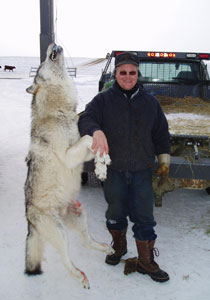
Biologists have identified an animal shot near Little Fish Lake last winter was a wolf, and what a wolf it was.
In The Mail’s January 12 edition, it reported that Ed Gammie killed the animal on his property. The animal weighed about 115 pounds and measured about 6 feet from nose to tail, large even by a wolf standard.
Local Fish and Wildlife submitted the skull to The University of Alberta to be properly identified.
Rob Losey, a member of the faculty of Anthropology at the University of Alberta and a palaeontologist colleague from Belgium identified the skull to be a typical adult wolf.
“We used a series of measurements on the wolf’s skull and compared them with measurements taken on a large group of North America (largely Alberta) and Eurasian wolves, as well as with those of dogs. We then used a multivariate statistical program to assess whether the skull more resembled a wolf or a dog,” said Losey.
Local Fish and Wildlife officer Byron Jensen explained that throughout history, animals have been most often catalogued by measurements, and these are used to determine the species. There is no simple DNA test. What also complicates the identification is that wolves and dogs have been mixing for centuries, and even if it appears as a wolf, it is difficult to say if it is a pure strain.
He said this occurrence of a wolf in the area is rare given the landscape and the fact the pack animal was alone. Having said that, it is not completely unexpected, as wild animals can have large and varied ranges. Resident sightings have confirmed the presence of cougars in the area over the past few years, and Jensen said every five or six years a black bear typically wanders down the river valley.
What also struck Jensen is the size. In comparing it with a wolf skull he had in the office, he concluded it is one big wolf.
Patty Ralrick, who is affiliated with the Royal Tyrrell Museum, confirmed his feeling. The subject of her masters research is on Little Fish Lake, and she took measurements of the skull. In her mind, there is no doubt it is a wolf. While they are a rarity today, in her field work she stumbled upon about a dozen skull in the Little Fish Lake area between 600 and 1,400 years old.
“It was the largest skull I had seen,” said Ralrick, who compared known wolf skulls in the Royal Alberta Museum and skulls collected by Alberta Fish and Wildlife.
“When I took all my measurements that I took of the skull of the wolf from the Delia area, and put it into my matrices, it fell out with the wolves, and actually very high. It is a very large animal … it is definitely one of the biggest skulls I have seen.”
Aside from just the size, she said the large size of the cutting teeth, the shape of auditory bullae and the shape of the skull tipped her off that it was a wolf.
As for Gammie, he has the skull to keep.
“I hope this is the last one I see,” he said.
















